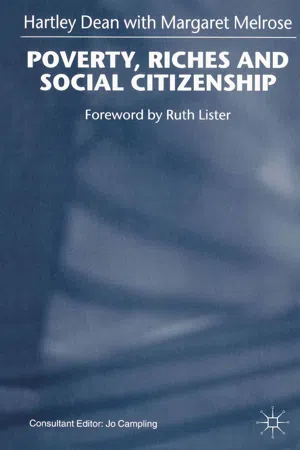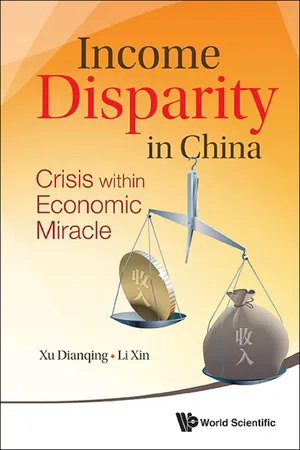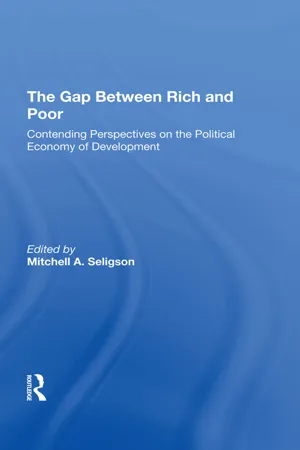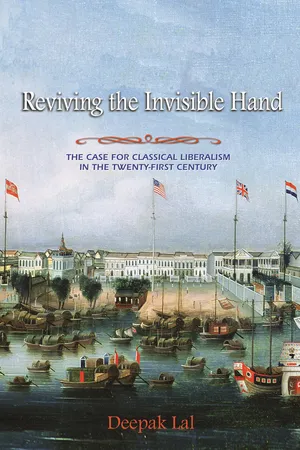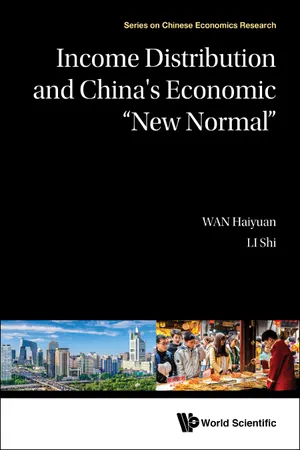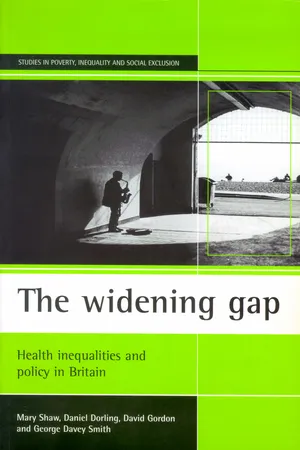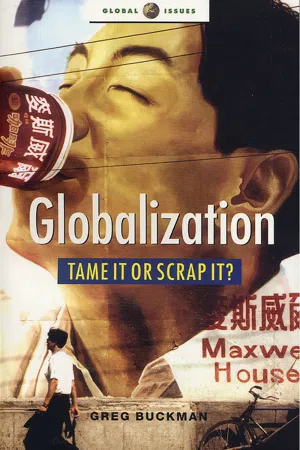Economics
The Gap between Rich and Poor
The gap between the rich and the poor refers to the disparity in income and wealth distribution within a society. It is a measure of economic inequality and can have significant social and political implications. Factors contributing to this gap include differences in education, access to resources, and economic policies. Addressing this gap is a key concern for policymakers and economists.
Written by Perlego with AI-assistance
Related key terms
1 of 5
8 Key excerpts on "The Gap between Rich and Poor"
- eBook - PDF
- Margaret Melrose, H. Dean, Kenneth A. Loparo, Jo Campling(Authors)
- 2015(Publication Date)
- Palgrave Macmillan(Publisher)
Others consider that it is right that competence, effort and achievement should be rewarded with riches, while incompetence, sloth and failure should be punished by poverty. It is possible that some may still believe that the respective statuses of the poor and rich are rightly and properly ascribed by birth or breeding. Defining poverty and riches is therefore ideologically controver- sial. What this chapter will do is first to discuss recent evidence concerning the gap between the rich and poor, before moving on to introduce the concepts of deprivation and privilege; concepts which have been developed in ways which to some extent sidestep the moral considerations outlined above. We shall then turn to the critical concept of social class and recent arguments that the na- ture of class and social divisions is changing. In the light of that discussion we shall outline a theoretical model which we plan to develop further in the course of the book in order to help under- stand the different ways in which people understand poverty and riches. The Gap between Rich and Poor During the last quarter of the twentieth century the gap between the richest and the poorest members of society increased, not only in the UK, but throughout the world. It is a trend which has been particularly marked in the UK, where the income share of the poorest tenth of the population fell from 4.2 per cent of national income in 1961 to 3.0 per cent in 1991, Of Poverty and Riches 3 Figure 1.1 Changing income inequality in the UK (Gini-coefficient for equivalent net incomes of individuals, after housing costs, with three year average smoothing, from 1961 to 1991) 0 m e n a I i t Y 0.400 0.375 0.350 0.325 0.300 0.275 0.250 0.225 0.200 0.175 0.150 '61 '63 '65 '67 '69 '71 '73 '75 '77 '79 '81 '83 '85 '87 '89 '91 Source: Goodman and Webb 1994 while that of the richest tenth rose from 2 per cent to 25 per cent (Goodman and Webb 1994: 66). - eBook - ePub
Income Disparity In China: Crisis Within Economic Miracle
Crisis within Economic Miracle
- Dianqing Xu, Xin Li(Authors)
- 2014(Publication Date)
- WSPC(Publisher)
Gini Coefficient: A Measure of the Gap between the Rich and the Poor The pairing of efficiency and equity has many contradictions. Under the planned economic system, too much emphasis on equality at the expense of efficiency leads to widespread poverty. Conversely, too much emphasis on efficiency increases the gap between the rich and the poor, which threatens social stability. Kuznets summarized the variation law on the gap between the rich and the poor in the process of economic development and proposed the well-known inverted U-shaped curve. Kuznets argues that the gap between the rich and the poor will increase in the early stages of economic development. However, the increase in per capita income will narrow the gap gradually. 4 The inverted U-shaped curve will not appear automatically. Therefore, the income gap should not be allowed to widen. Kuznets advocates the use of financial subsidies, social welfare, and other secondary means of distribution to help the poor. He also recommends implementation of the graduated tax system to target the inheritance and the capital income of the rich to bridge the gap between the rich and the poor. If the government policies fail, the gap between the rich and the poor is likely to continue to widen, subvert the social stability, and terminate the economic growth. Todaro and other economists analyzed the data of 43 developing countries and found that the benefits of economic growth would not flow automatically to the extreme poverty groups. In many countries, despite economic development, the poor’s absolute income and relative income have declined. However, exceptions exist such as the cases of Taiwan and South Korea. The Gini coefficients in China’s Taiwan region and South Korea did not increase significantly despite economic growth. 5 In other words, high economic growth does not necessarily lead to the deterioration of income distribution, and low economic growth does not mean equality of income distribution - eBook - ePub
The Gap Between Rich And Poor
Contending Perspectives On The Political Economy Of Development
- Mitchell A Seligson(Author)
- 2019(Publication Date)
- Taylor & Francis(Publisher)
Defining The Gap between Rich and PoorPassage contains an image
1.The Dual Gaps: An Overview of Theory and ResearchMitchell A. SeligsonThe income gap between rich and poor countries has grown dramatically over the past 30 years. In 1950, the average per capita income (in 1980 U.S. dollars) of low-income countries was $164, while the per capita income of the industrialized countries averaged $3,841, yielding an absolute income gap of $3,677. Thirty years later, in 1980, incomes in the poor countries had risen to an average of only $245, while those in the industrialized countries soared to $9,648; the absolute gap in 1980 stood at $9,403. For this period, then, there is clear evidence to support the old adage that “the rich get richer.” It is not true that the poor get poorer, but that would be a perverse way of looking at these data. A more realistic view of the increases in “wealth” in the poor countries would show that in this thirty-year period the poor countries increased their incomes by an average of only $2.70 a year, less than what an American might spend for lunch at a neighborhood fast-food stand. And in terms of relative wealth, the poor countries certainly did get poorer; the total income (gross national product or GNP) of the low-income countries declined from 4.3 percent of the income earned by the industrialized countries in 1950 to a mere 2.5 percent by 1980.1One might suspect that these data do not reflect the general pattern of growth found throughout the world, but are influenced by the disappointing performance of a few “basket case” nations. That suspicion is unfounded. The low-income countries comprise nearly half the world’s population; more than two billion people live in countries with incomes of less than $400 a year. It is also incorrect to speculate that because some poor countries have recently outperformed the growth rates of the industrialized countries that the gap will soon be narrowed. In Chapter 2 - eBook - PDF
American Dilemmas
A Sociological Interpretation of Enduring Social Issues
- Jonathan H. Turner, David Musick(Authors)
- 2019(Publication Date)
- Columbia University Press(Publisher)
Chapter 7 Wealth and Poverty T h e United States probably reveals a large poverty sector. Juxtaposed to such poverty is a relatively small wealth-holding elite. And between these two extremes is a large grouping of middle Americans who enjoy varying degrees of relative affluence. The existence of concentrated wealth and pauperism is not coincidental. One contributes to the other. The persistence of poverty in the midst of affluence has posed an enduring dilemma for Americans. This dilemma must, however, be viewed in the more general context of in-equality. Indeed, one of the great failings of social science is its tendency to analyze poverty per se without at the same time recognizing that the existence of poverty is tied to the dynamics of inequality in America. 1 Inequality can be defined as the differential distribu-tion of those resources that members of a society value. The three most basic resources are (1) material wealth, or the money to buy material goods, (2) power, or the capacity to control others, and (3) prestige, or the honor and esteem that one receives from others. 2 In all but the simplest societies, material wealth, power, and prestige are distributed un- WEALTH AND POVERTY 175 equally. Some get more of these valued resources than oth-ers. Many of the dynamics of a society are inevitably influ-enced by how these resources are distributed. Societies that distribute these resources unequally—where relatively few get most of the wealth, power, and prestige—will be very differ-ent from societies that distribute these resources more equally—where most everyone enjoys some wealth, power, and prestige. And because much of what occurs in any society is tied to patterns of inequality, we should not be surprised to discover that many of America's most enduring social dilem-mas inhere in the distribution of these resources. The Dynamics of Inequality Ultimately, the degree of inequality in a society is con-nected to the level of productivity in its economy. - eBook - PDF
Reviving the Invisible Hand
The Case for Classical Liberalism in the Twenty-first Century
- Deepak Lal(Author)
- 2010(Publication Date)
- Princeton University Press(Publisher)
This shows that, while in 1960 per capita incomes of the richer countries were twenty-three times that of the poorest twenty countries, by 2000 this gap had increased to thirty-six. 8 The trick lies in using the shifting composi- tion of the poorest countries over time to make the comparison. This is like P O V E RT Y A N D I N E Q U A L I T Y 135 using an elastic ruler. For the comparison to have any meaning, one must keep the base constant, that is, one should see what has happened to the gap between the same set of countries—rich and poor—over time. Bhalla does this. The results from the World Bank method (using the shifting composi- tion of countries) and Bhalla’s method (of using the same set of countries) is shown in figure 5.2. The gap, on the correct method, instead of rising, declines substantially from 23 in 1960 to 9.5 in 2000. Moreover, the largest decline in The Gap between Rich and Poor countries has occurred in the two decades of globalization since the 1980s. The World Bank has again perpetuated a myth based on statistical chicanery which has aroused anti-globalization passions. But, whereas some might find it of interest to see how The Gap between Rich and Poor countries has changed with globalization, from the viewpoint of judging the changes in welfare of people, we need to see how the incomes of the world’s citizens have changed over the years. For this we need esti- mates of the distribution of income between all the people of the world, ig- noring their place of residence—their countries. Bhalla has estimated these distributions for the post–Second World War period, as has Sala-Martin (for 1970–1998) based on the same data but using somewhat different methods. Their results are very similar. A summary statistic to measure inequality is the Gini coefficient. - Haiyuan Wan, Shi Li(Authors)
- 2019(Publication Date)
- WSPC(Publisher)
Table 5.1 ). As shown in the table, the income gap is narrowing in the Latin American countries while widening in the high-income countries like France and Germany, where the income gap used to be small. The income gap is also expanding in some major powers, such as the United States and China, during this period. In addition, except Bulgaria, most transition economies (Russia, the Czech Republic, Romania, Hungary, Ukraine, etc.) see decreasing or constant income gap. In general, the pattern of income distribution has undergone some changes in recent years across the world. The Latin American countries see a narrowing income gap that used to be large, while some western European countries have seen their relatively small income gap widening recently.Table 5.1. Changes of Income Gap within Different Countries/Regions During 2005–2013.Notes: (1) Based on the 2005–2013 income Gini coefficients of the world; (2) the change of the income gap is defined by the relative change 3% of the Gini coefficient.IV.Income Gap Between China and Other CountriesOn the basis of global experience, the World Bank has warned the middle-income countries that even though some developing countries have entered the middle-income ranks after stepping out of the “low-level equilibrium trap” with their economic development level exceeding per capita GDP of USD 1,000, few countries can successfully become high-income economies but remain in the middle-income group for a long period of time, either caught in a repeated cycle of growth and decline or in a prolonged phase of slow or zero growth. In 2010, China’s GDP per capita finally reached the lower edge of the “upper middle-income” group, leaving the “lower middle-income” group. This is a historic moment as it marks a new page of China’s modernization where new challenges are awaiting. In this context, it is particularly important to explore the issue of middle-income trap from an international comparative perspective. In particular, it is necessary to understand the income distribution of the countries that has entered the lower middle- or upper middle-income group. Therefore, this section will continue to compare China’s income difference with that of other similar countries, so as to provide empirical lessons for China to overcome the “middle-income trap”.- eBook - PDF
The widening gap
Health inequalities and policy in Britain
- Shaw, Mary, Dorling, Daniel(Authors)
- 1999(Publication Date)
- Policy Press(Publisher)
The widening income gap Changing patterns of employment are only part of the explanation for the widening income and wealth gaps in Britain which we claim drive growing inequalities in health. To look at household fortunes in the round, however, we need to consider changes in all sources of income and wealth. First we consider changes in those without either income or wealth – the poor. Poverty – international comparisons Poverty and income inequality have been rising faster in Britain than in other developed countries since the late 1970s. For example, Bradshaw and Chen (1997) looked at levels of poverty in Australia, Canada, Germany, Israel, the Netherlands, Norway, Sweden,Taiwan, the UK and USA at circa 1979, 1985 and 1990. Poverty was defined as households having below 50% average income after social security benefits and direct taxes. They concluded that: There has been an increase in poverty in all countries except Israel and Canada over this period between 1979 and 1990 but by far the sharpest increase in poverty has occurred in the UK where between 1979 and 1990 the poverty rate more than doubled. (Bradshaw and Chen, 1997, p 17) - eBook - PDF
Globalization
Tame It or Scrap It?
- Greg Buckman(Author)
- 2008(Publication Date)
- Zed Books(Publisher)
1 This analysis is echoed by David Landis, Professor Emeritus of History and Economics at Harvard University. He says, ‘the difference in income per head between the richest industrial nation, say Switzerland, and the poorest non-industrial country, Mozambique, is about to one. Two hundred and fifty years ago, this gap between richest and poor-est was perhaps five to one, and the difference between Europe and, say, East or South Asia (India or China) was around . or Source : Ankie Hoogvelt, Globalization and the Post Colonial World , Palgrave, London, , p. . Figure . Per capita incomes of world’s richest and poorest countries (richest as a multiple of poorest) ‒ ‒ ‒ ‒ ‒ ‒ ‒ ‒ ‒ two to one’. 2 This is not to say that everyone was rich years ago; they weren’t – nearly everyone was poor then. But over the period since only a select few have grown richer and the rest have been left behind. Wealth and income statistics are the bottom line: they are the scorecard that matters most when evaluating the performance of economic globalization. Wealth and income statistics have to be treated carefully, however, and, unfortunately, the anti-globalization movement has sometimes not shown enough care with its use of them (similarly, the movement often shows insufficient care when comparing the sales of transnational corporations with the gross domestic products of nations). Critics of the anti-globalization movement argue, on a philosophical level, that relative wealth differences don’t matter – it’s changes in the absolute wealth, or bottom-line poverty, of poor people that matter.
Index pages curate the most relevant extracts from our library of academic textbooks. They’ve been created using an in-house natural language model (NLM), each adding context and meaning to key research topics.
